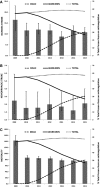Temporal Trends in the Use and Comparative Effectiveness of Direct Oral Anticoagulant Agents Versus Warfarin for Nonvalvular Atrial Fibrillation: A Canadian Population-Based Study
- PMID: 29080863
- PMCID: PMC5721787
- DOI: 10.1161/JAHA.117.007129
Temporal Trends in the Use and Comparative Effectiveness of Direct Oral Anticoagulant Agents Versus Warfarin for Nonvalvular Atrial Fibrillation: A Canadian Population-Based Study
Abstract
Background: Direct oral anticoagulants (DOACs) are noninferior to warfarin for stroke prevention in atrial fibrillation (AF). We aimed to determine the population risk of stroke and death in incident AF, stratified by anticoagulation status and type, and the temporal trends of oral anticoagulation practice in the post-DOAC approval period.
Methods and results: We conducted a population-based cohort study of incident nonvalvular AF cases using administrative health data in Alberta, Canada. We used Cox proportional hazards modeling with anticoagulation status as a time-varying exposure and adjusted for age (continuous), sex, congestive heart failure, hypertension, diabetes mellitus, prior transient ischemic attack or ischemic stroke, myocardial infarction, peripheral artery disease, and chronic kidney disease. Primary outcome was the composite of stroke and death. Among 34 965 patients with incident AF (56.0% male, median age 73 years), relative to warfarin, DOAC use was associated with decreased risk of all stroke and death (hazard ratio: 0.90; 95% confidence interval, 0.83-0.97) and decreased hemorrhagic stroke (hazard ratio: 0.60; 95% confidence interval, 0.40-0.91]) but a similar risk of ischemic stroke (hazard ratio: 1.12; 95% confidence interval, 0.94-1.34]). During this time period, DOAC use increased rapidly, surpassing warfarin, but the total oral anticoagulation use in the population remained stable, even in the subgroup with the highest thromboembolic risk.
Conclusions: In a real-world population-based study of patients with incident AF, anticoagulation with DOACs was associated with decreased risk of stroke and death compared with warfarin. Despite a rapid uptake of DOACs in clinical practice, the total proportion of AF patients on anticoagulation has remained stable, even in high-risk patients.
Keywords: anticoagulant; atrial fibrillation; mortality; stroke.
© 2017 The Authors. Published on behalf of the American Heart Association, Inc., by Wiley.
Figures



Similar articles
-
Prescription Patterns and Outcomes of Patients With Atrial Fibrillation Treated With Direct Oral Anticoagulants and Warfarin: A Real-World Analysis.J Cardiovasc Pharmacol Ther. 2019 Sep;24(5):428-434. doi: 10.1177/1074248419841634. Epub 2019 Apr 29. J Cardiovasc Pharmacol Ther. 2019. PMID: 31035795
-
Periprocedural Outcomes of Direct Oral Anticoagulants Versus Warfarin in Nonvalvular Atrial Fibrillation.Circulation. 2018 Oct 2;138(14):1402-1411. doi: 10.1161/CIRCULATIONAHA.117.031457. Circulation. 2018. PMID: 29794081
-
Effectiveness and Safety of Direct Oral Anticoagulants in Relation to Temporal Changes in Their Use.Circ Cardiovasc Qual Outcomes. 2020 Mar;13(3):e005894. doi: 10.1161/CIRCOUTCOMES.119.005894. Epub 2020 Mar 12. Circ Cardiovasc Qual Outcomes. 2020. PMID: 32160790
-
The Tasmanian atrial fibrillation study: Transition to direct oral anticoagulants 2011-2015.Cardiovasc Ther. 2017 Jun;35(3). doi: 10.1111/1755-5922.12254. Cardiovasc Ther. 2017. PMID: 28177198
-
Real-world Comparisons of Direct Oral Anticoagulants for Stroke Prevention in Asian Patients with Non-valvular Atrial Fibrillation: a Systematic Review and Meta-analysis.Cardiovasc Drugs Ther. 2019 Dec;33(6):701-710. doi: 10.1007/s10557-019-06910-z. Cardiovasc Drugs Ther. 2019. PMID: 31745687
Cited by
-
Surveillance for Outcomes Selected as Atrial Fibrillation Quality Indicators in Canada: 10-Year Trends in Stroke, Major Bleeding, and Heart Failure.CJC Open. 2021 Jan 13;3(5):609-618. doi: 10.1016/j.cjco.2021.01.003. eCollection 2021 May. CJC Open. 2021. PMID: 34036258 Free PMC article.
-
Direct Oral Anticoagulants as the First Choice of Anticoagulation for Patients with Peripheral Artery Disease to Prevent Adverse Vascular Events: A Systematic Review and Meta-Analysis.J Cardiovasc Dev Dis. 2023 Feb 3;10(2):65. doi: 10.3390/jcdd10020065. J Cardiovasc Dev Dis. 2023. PMID: 36826561 Free PMC article. Review.
-
Supporting anticoagulant treatment decision making to optimise stroke prevention in complex patients with atrial fibrillation: a cluster randomised trial.BMC Fam Pract. 2020 Jun 8;21(1):102. doi: 10.1186/s12875-020-01175-0. BMC Fam Pract. 2020. PMID: 32513116 Free PMC article. Clinical Trial.
-
Trends in Oral Anticoagulant Use Among 436 864 Patients With Atrial Fibrillation in Community Practice, 2011 to 2020.J Am Heart Assoc. 2022 Nov 15;11(22):e026723. doi: 10.1161/JAHA.122.026723. Epub 2022 Nov 8. J Am Heart Assoc. 2022. PMID: 36346063 Free PMC article.
-
Risks of Stroke and Mortality in Atrial Fibrillation Patients Treated With Rivaroxaban and Warfarin.Stroke. 2020 Feb;51(2):549-555. doi: 10.1161/STROKEAHA.119.025554. Epub 2019 Dec 31. Stroke. 2020. PMID: 31888412 Free PMC article.
References
-
- Hart RG, Pearce LA, Aguilar MI. Meta‐analysis: antithrombotic therapy to prevent stroke in patients who have nonvalvular atrial fibrillation. Ann Intern Med. 2007;146:857–867. - PubMed
-
- Connolly SJ, Ezekowitz MD, Yusuf S, Eikelboom J, Oldgren J, Parekh A, Pogue J, Reilly PA, Themeles E, Varrone J, Wang S, Alings M, Xavier D, Zhu J, Diaz R, Lewis BS, Darius H, Diener HC, Joyner CD, Wallentin L; Re‐LY Steering Committee and I . Dabigatran versus warfarin in patients with atrial fibrillation. N Engl J Med. 2009;361:1139–1151. - PubMed
-
- Giugliano RP, Ruff CT, Braunwald E, Murphy SA, Wiviott SD, Halperin JL, Waldo AL, Ezekowitz MD, Weitz JI, Spinar J, Ruzyllo W, Ruda M, Koretsune Y, Betcher J, Shi M, Grip LT, Patel SP, Patel I, Hanyok JJ, Mercuri M, Antman EM; Investigators EA‐T . Edoxaban versus warfarin in patients with atrial fibrillation. N Engl J Med. 2013;369:2093–2104. - PubMed
-
- Granger CB, Alexander JH, McMurray JJ, Lopes RD, Hylek EM, Hanna M, Al‐Khalidi HR, Ansell J, Atar D, Avezum A, Bahit MC, Diaz R, Easton JD, Ezekowitz JA, Flaker G, Garcia D, Geraldes M, Gersh BJ, Golitsyn S, Goto S, Hermosillo AG, Hohnloser SH, Horowitz J, Mohan P, Jansky P, Lewis BS, Lopez‐Sendon JL, Pais P, Parkhomenko A, Verheugt FW, Zhu J, Wallentin L; Committees A Investigators . Apixaban versus warfarin in patients with atrial fibrillation. N Engl J Med. 2011;365:981–992. - PubMed
Publication types
MeSH terms
Substances
LinkOut - more resources
Full Text Sources
Other Literature Sources
Medical

